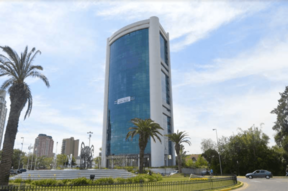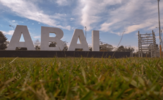Abaí facts for kids
Quick facts for kids
Abaí
Ava'i
|
||
|---|---|---|
|
District
|
||
|
Clockwise from top: a building in Abaí, the welcoming sign of the city and a traditional dance taking place in an Abaí school.
|
||
|
||
| Etymology: Small person | ||
| Nickname(s):
The Last Stop
|
||
| Government | ||
|
• Mayor
|
Christian Andrés Acosta (ANR) | |
| Area | ||
|
• Total
|
2,018 km2 (779 sq mi) | |
| Elevation | 155 m (509 ft) | |
| Population | ||
|
• 2023 estimate
|
33,792 | |
|
• Density
|
16.12/km2 (41.8/sq mi) | |
| Time zone | UTC-4 | |
| Calling code | 544 | |
| Website | https://www.muniabai.gov.py | |
Abaí (in Guarani: Ava'i) is a district in Caazapá, Paraguay. It is the largest district in its department. Abaí is also one of Paraguay's biggest farming areas.
The Caazapá Range divides Abaí into two main parts. The "low zone" has most of the businesses. The "high zone" is home to Tupã Renda, a very productive company.
Contents
What Does Abaí Mean?
Abaí used to be a wild, swampy place. Early workers cut down trees with axes. They faced dangers like wild animals in the thick forests.
Sometimes, they saw people from the Aché or Mbya Guarani tribes. Because it was hard to see, the workers thought these people moved like mythical beings. They called them ava'i, which means "small person" in Guaraní. This is how Abaí got its name.
Abaí's History
Early Years of Abaí
Abaí started as a small settlement in the early 1900s. It was part of San Juan Nepomuceno. On October 4, 1960, Abaí became its own municipality.
The first people to settle here were workers hired by José Fassardi. He was a rich Italian businessman. In 1914, he set up a large sawmill with other partners. This sawmill also made electricity.
Fassardi's company bought a huge area of forest, including all of Abaí.
In 1918, the FCCP train line reached Abaí. At first, it carried wood and workers to the sawmill. Later, it also carried people. A train station was built, meant to connect all the way to Foz do Iguaçu. But this project was never finished. So, Abaí became the "last stop" on the line, which is why it has that nickname.
Abaí During the Chaco War
During the Chaco War, soldiers from Abaí were sent to the battle zones. This happened because of orders from Colonel José Félix Estigarribia. The trains carried wagons full of these soldiers.
World War II and Abaí
During World War II, Paraguay sold goods like beef, grain, cotton, and wood to the United States. This was good for many farmers in Abaí. They could sell their products, which were sent by train. Even though people in Abaí didn't know where their goods were going, this trade brought important income to the district in the 1940s.
Abaí Becomes Independent
In 1955, the first small church, called an oratory, was built in Abaí. It was dedicated to Saint Sebastian. Between 1956 and 1957, a priest from San Juan Nepomuceno helped draw the boundaries for new towns. Each of these towns would later get its own oratory.
In 1958, Abaí's church became separate from San Juan Nepomuceno's. This led to Abaí becoming its own district later on.
Important people worked together to make Abaí an independent district. They met at the home of Adolfo Vázquez, who was the first JP (a local official). On October 4, 1960, Abaí officially became a district by law.
In 1962, the main city church was built. This happened after Father Juan de Dios Bogado arrived. The city's central square is named after him. Father Bogado helped spread the Christian faith in the town.
Abaí After 1989
After 1989, Abaí started having elected mayors. The first mayor chosen directly by the president was Juan Ramón Troche. The first elected mayor was Celina Roa de Morel.
Today, Abaí has many schools. It has nine educational centers, sixty elementary schools, nineteen middle schools, and eight special centers for young people and adults. It also has a health center, seven family health units, and three health posts. Six police stations help keep the district safe. The Aché and Mbya Guarani are two native tribes that have their own settlements here.
Abaí's Geography
Abaí has 54 smaller areas and is divided into two main zones:
- The High Zone: This part is mostly high ground. It is in the northwest and has many Brazilian immigrants.
- The Low or Southeast Zone: This is a large flat area. The Capiibary River flows through it. The district's main town and most of its people live near this river.
A large part of Abaí sits above the Guarani Aquifer, which is a huge underground water source. The Capiibary River separates Abaí from Caaguazú. The Monday and Ypeti rivers separate it from Alto Paraná.
Abaí has many streams, including Capiibary Guazú, Chakira, and Cristal. Most of the Caazapá National Park is also located in Abaí.
The area called Ka'aguy Juru (which means "the forest's mouth" in Guaraní) used to be the entrance to a forest. This forest was full of native trees like lapacho, cedar, and yvyra pytã.
Culture in Abaí
Abaí celebrates its main festival on January 20. This day honors Saint Sebastian, the district's patron saint. The main activities in Abaí are farming, raising animals, and working with forests.
The most popular sport in Abaí is football. The Abaí Football League has ten teams and plays in tournaments.
The city also holds folklore shows and music festivals every year. One of the most famous is the Kapi'ivary Purahéi Festival, which is considered one of the best in Paraguay.
See also
 In Spanish: Abaí para niños
In Spanish: Abaí para niños






